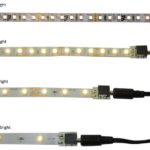An educated LED lighting buyer is a confident buyer
LEDs, or Light Emitting Diodes, have been used for years in various applications, however they have just recently hit it big in the commercial market due to new innovations, making them more affordable and easier to use for the end-user (or, you!). Today’s readily accessible LED products can still be a bit confusing for those who have never worked with LEDs, or even those who have never purchased lighting from Inspired LED. We have come up with this easy overview of LED lighting to help you navigate your way through the waters and help you understand which myths and misconceptions you should just forget about.
“Don’t all LEDs have a blue-ish color? I don’t know if I want that.”
No! And stop reading those horrifically out-of-date and misinformed articles! You know how Apple is constantly coming out with new generations of the iPhone each year? LED Technology is ever-changing and improving, which also applies to LED lights. Where would we be if we still had the LED lights from yester-year? I’ll tell you where: You would be sitting in really brightly lit rooms that would feel like a laboratory or a doctor’s office. (Yes, there are many very appropriate settings for cool white lighting… we’ll get to that later.)
Are you lighting your kitchen? Go with warm white LEDs for kitchen lighting. We repeat this many times a day and we will continue doing so- light your kitchen with LEDs on the warmer spectrum. Our warm white LEDs are 3200K, but you will find something around the high 2000Ks will work well too. They will match with most incandescent overhead lighting. And, let’s face it, warmer tones tend to look better in the kitchen and make food look more appealing. There are certain kitchens that look absolutely fantastic with cool white LEDs, but for the other 95% of us, warm white is the perfect hue. Cool white LEDs are great for offices, garages, workshops, display cases, and more.
“I don’t want LEDs because don’t dim.” Like we mentioned before, technology is ever changing, especially in the LED lighting world. In the past, a major deal breaker when choosing between lighting options was whether or not the lights would be dimmable. Now, you don’t have to choose the heart breaking option to go for something other than LED lighting. The vast majority of LED lights can be dimmed through wall dimmers, wireless dimmers, and in-line dimmers.
“My electrician said that I need to hardwire my lights.” You don’t need to- You can either plug your lights into an electrical outlet or you can hardwire them. Both of these require this question first: How do you want to control your lights? If you want to control you lights by a wall dimmer, you will need to hardwire a dimmable transformer into your system (installed by an electrician). If you want to control your lighting by something other than a wall dimmer- say, a wall switch, under cabinet dimmer or switch, wireless dimmer– you have a few different options. You can create an outlet and plug in your power supply. You can use our convenience box, wired to pre-existing wires, to create an outlet. Read our Retrofitting Blogs Part 1 and Part 2 to gain more insight on how to make the move from your existing lights to LED lights.
Look out for more buying assistance and misconceptions in Part 2 of this series! For immediate help, please feel free to contact us at 480-941-4286.




